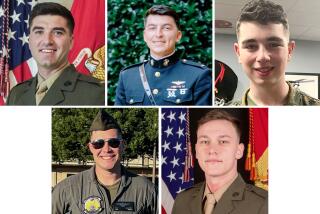Journalists Join Him for Ride in Super Stallion : Navy Boss Puts His Trust in Copter
- Share via
In a public show of support for the CH-53E Super Stallion, Secretary of the Navy James H. Webb Jr. joined Marines Friday for a 30-minute ride from San Diego to the Tustin Marine Corps Air Station in one of the crash-prone transport helicopters.
“You can’t really ask others to fly in aircraft that you won’t fly in,” said Webb, a Vietnam veteran who earned two Purple Hearts as a rifle platoon leader and later served as a company commander in the 1st Battalion, 5th Marine Regiment.
Since they were put into service as Marine transport and troop carriers in 1981, Super Stallions, which cost up to $20 million each, have been involved in nine serious crashes that have killed 20 people and injured another 17.
During the flight along the coast Friday from the North Island Naval Air Station on Coronado to the Orange County Marine base, Webb sat in a cockpit jumpseat between two Marine pilots. He wore an aviator’s helmet and a harness connecting him to the ceiling of the aircraft to prevent him from falling out an open window at 145 m.p.h.
“I wanted to demonstrate that I have confidence in the helicopter,” Webb said as he left the aircraft with Maj. Gen. Donald E.P. Miller, commanding general of the Third Aircraft Wing headquartered at the nearby El Toro Marine Corps Air Station.
More than half of the 90 Super Stallions are stationed at the Tustin base. The entire fleet was grounded in February because of transmission troubles, but about 60% are back in the air.
The helicopter has also had tail rotor problems resulting in two crashes, but military officials have said that problem has been resolved.
After the most recent Super Stallion crash, last January in the Imperial County desert near the Salton Sea, Rep. Robert E. Badham (R-Newport Beach) in early March called for the indefinite grounding of the helicopters until the source of in-flight vibrations could be determined. Although a grounding was not ordered in that case, restrictions were placed on use of the aircraft.
Sikorsky Aircraft of Stratford, Conn., is conducting tests to determine the seriousness of the vibrations; the results should be available by next summer.
The Super Stallion is the largest heavy-lift, troop-carrying helicopter built outside the Soviet Union. It can carry up to 55 combat troops or externally hoist up to 16 tons. Super Stallions are used primarily by the Marine Corps and the Navy.
Vietnam Experience
Webb, who replaced John Lehman as Navy secretary last April, said the Super Stallion controversy came to his attention just after he took office.
“I was very surprised to hear that some had hesitations about the CH-53E,” Webb said, adding that as a Marine in Vietnam he was familiar with the earlier CH-53 models.
“They had a good reputation of being able to take ground fire and still move out,” he said.
Webb, the author of several best-selling books, pointed out that it is not taxpayers but Sikorsky Aircraft that is paying for tests to determine the seriousness of in-flight vibrations.
Pilots have told The Times in recent interviews that they were aware of the in-flight vibrations and have been trained to fly the helicopter in such a way that the vibrations do not occur.
Webb requested the ride in the Super Stallion during a tour of West Coast Marine and Navy facilities. Two of the helicopters were flown to San Diego Thursday. Both were flown back Friday.
Miller, who officially took over as commanding general of the Third Marine Aircraft Wing on Monday, personally arranged for the ride. Webb spent Friday afternoon with CH-53E pilots and crew members before returning to Washington. He said he expected to “learn a lot” from the Marines who are around the helicopter every day.
Webb’s support could be crucial in decisions on future production of the helicopter. Both the House and Senate included language in the upcoming federal budget requiring that the vibration problem be solved or explained.
Miller invited newspaper reporters to fly in the Super Stallion with Webb--the first time that reporters had been allowed to ride in Super Stallions based at Tustin.
The three jet engines that power the Super Stallion produce a deafening noise, even when idling on the ground. This necessitates that crew members and passengers wear noise-protection devices over their ears.
During the flight, the helicopter, which taxis and takes off much like an airplane, climbed to 4,000 feet, breaking cloud cover at 3,000 feet.
The three engines produce nearly 13,000 horsepower, creating a trembling as the 16-ton aircraft climbs. The odor of jet exhaust is evident in the 30-foot-long cabin where passengers sit.
Even at speeds near 150 m.p.h., two large windows in the forward part of the cabin are left open so the crew chief and his assistant can lean out to spot other aircraft nearby. They wear harnesses and straps to prevent them from falling out during sharp turns or turbulence.
The main rotors are 79 feet in diameter. They produce a pounding sound as they split the air at nearly 500 m.p.h.
The Super Stallion is a military workhorse. The inside is not finished like the inside of a commercial airliner. Bundles of wires peek out from behind the cockpit panels that hold hundreds of dials and instruments.
In an interview before the flight, Miller said if there are vibration problems, the current tests at Sikorsky should find them.
Miller pointed out that there “is no lack of confidence among those who fly the aircraft.” He said not one pilot or co-pilot has ever refused to fly the Super Stallion.
That, he said, may be a very important statistic.
More to Read
Sign up for Essential California
The most important California stories and recommendations in your inbox every morning.
You may occasionally receive promotional content from the Los Angeles Times.













